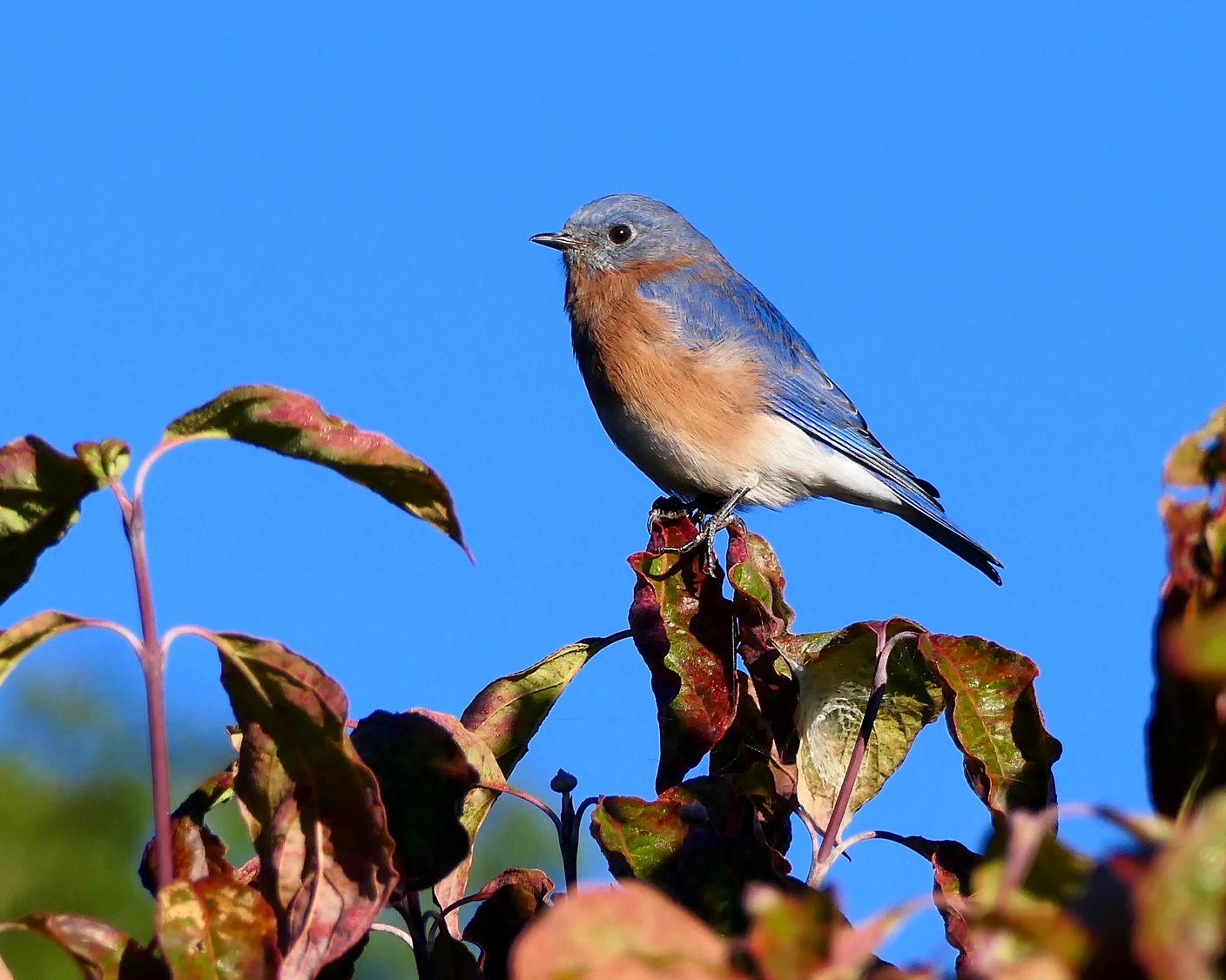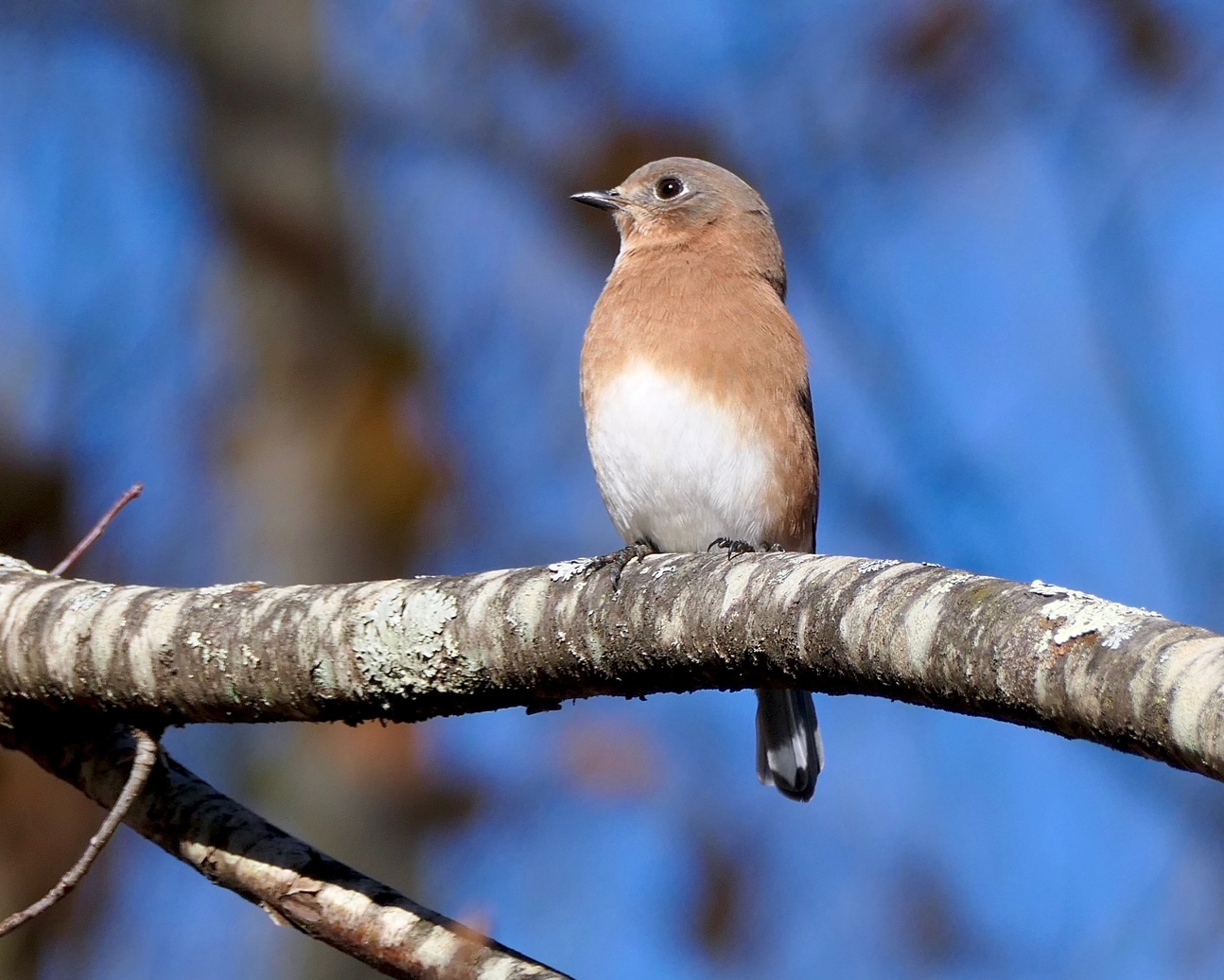Birds at Holcomb Farm
The Bluebirds are Back!
by Shirley Murtha

Bluebirds are being welcomed all over town this spring! Whether it has anything to do with climate change, it seems that there are more than usual appearing in our backyards. In addition to having difficulty contending with killing winter temperatures, another factor in their dwindling numbers in our are during the past several decades is that house wrens, tree swallows, alien house sparrows and starlings have crowded the gentle Blues out of nearly all available nesting places.
Bluebirds make their nests from grass and stems in shrubs and trees. They have been known to construct them as high as 20 feet off the ground. The male will attract a female to a prospective site, and he may put a few grasses in it, but once the female accepts the site, she takes over to complete the nest and will be the sole incubator of the eggs. Females can lay 3-7 pale blue eggs that hatch in a little over two weeks. The chicks stay in the nest, being fed insects and spiders and berries, for almost three weeks before the fledglings depart, hopping around on the ground and learning to fly.
Most everyone is familiar with the bright blue, rusty breast and white abdomen of the male – one of our most beautifully colored songbirds. Not everyone realizes that the much “duller” bird usually accompanying him is the female. She does not have the bright blue color, but is mostly grayish/brown on her back. She does retain the rusty breast and white abdomen, however.
One of the factors leading to the Bluebird resurgence we are experiencing is that organizations and individual homeowners have taken up the cause of placing Bluebird nesting boxes in the birds’ preferred locations: open grassland with a background of trees. Specific instructions for building your own box can be found online, and most now come with instructions on how to include a protective barrier at the entrance.
As with most nesting songbirds, their eggs and chicks are highly sought after by cats, snakes, raccoons and predatory birds. If snakes are an issue in your area, plastic sheeting on the box post will impede their progress, and a slinky placed around the post will make it near impossible for the reptile and most other predators to get up to the nest.
If you want to attract Bluebirds to your yard, put out their favorite food: mealworms. Mealworms are not worms at all, but the larval form of the common darkling beetle. No need to buy fresh squirmy ones, bags of dried ones are available at pet shops and farm supply stores. Be sure to get a lot, because it turns out that all the songbirds love them!

A Winter Visitor – The Black-capped Chickadee
by Shirley Murtha

One of the most common birds to see during the cold winter months is the black-capped chickadee, for these are non-migratory inhabitants of all of the North American continent’s deciduous and mixed forests. They are able to lower their body temperature as much as 12-15 degrees from their normal 108 degrees F. when they sleep on cold winter nights – a feat that is quite unusual in birds.
During the winter, chickadees travel and nest in flocks of eight to a dozen, looking for eggs and pupae to eat, as the insects and berries they choose in the summer are not available. They are also one of the most common visitors to household bird feeders. They are confident around humans, and can be trained to eat seed from an outstretched hand. Another remarkable characteristic of chickadees is that they can remember up to a month where they have stored food! Even squirrels are not very good at that.
Another interesting behavorial characteristic of chickadees is that while traveling in their flocks, the first one to see a predator gives a special warning call, which causes all the others to freeze in place. Once settled, they all begin to emit high-pitched vocalizations that sound as if they are coming from all different directions. The predator is confused and not knowing where to initiate an attack, eventually flies off. At that time, the lead bird issues an “all is well” note and the flock comes back to life.
Come April, chickadees will be back on their own, constructing loose cups of plant fibers, moss and feathers in a tree cavity or next box. Five to ten eggs can be laid from April through June. Incubation is 11-13 days and the young leave the nest 114-18 days from hatching.
A Summer Visitor – The Tree Swallow
by Shirley Murtha

Tree swallows lay 4-6 white eggs in a feather-lined cup of grasses that they make inside the hole of a tree or in a nest box. The feathers, which are gathered chiefly by the males, help to insulate the nest from cold temperatures. Females incubate the eggs for about two weeks; both parents bring insects to the hatchlings. Fledging occurs about three weeks after the hatch. The great majority of tree swallows return to nest in the same area, sometimes even the same box or tree that they used the previous year.
The tree swallow’s East Coast range encompasses areas from Newfoundland down to Maryland. They winter typically in the Carolinas and the Gulf Coast. In the fall, they gather in very large flocks along the coast where they “circle in big eddies like leaves caught in a whirlwind,” according to the Audubon Society’s Field Guide. They are among the first birds to reappear in Connecticut in the spring.
The males are identified by the glossy blue-green on their back and the top of their head, with blackish wings and tail feathers. They have white neck, chest and abdomen feathers. The females, as so often the case with birds, are much less showy, the youngest ones being predominantly brown with just a few bright feathers.
Tree swallows eat mostly insects that they catch on the fly, usually a little less than 200 feet above ground, although they can occasionally take some from the ground or the water. They sometimes include spiders and small berries in their diet. They are called “income breeders’ as they breed based on food abundance.
Tree swallows have an average lifespan of 2.5 years but have been known to be as old as 12 years in prime habitats. Almost 80 percent of the hatchlings do not survive their first year, mostly because of cold weather reducing insect availability. Also, they are preyed upon by kestrels, magpies, owls, falcons, and hawks. In addition, they suffer from the clearing of forests in their breeding areas and the reduction of marshes in their wintering areas, and they compete for nest sites with starlings, house sparrows and bluebirds. Despite all these difficulties, the tree swallows are doing well enough to not be included on the endangered species list.

Checklist of Birds at Holcomb Farm
To download a list of birds seen at Holcomb Farm, as compiled by bird enthusaiast and Friend of Holcomb Farm John Weeks, click here: Holcomb Farm Birds.
